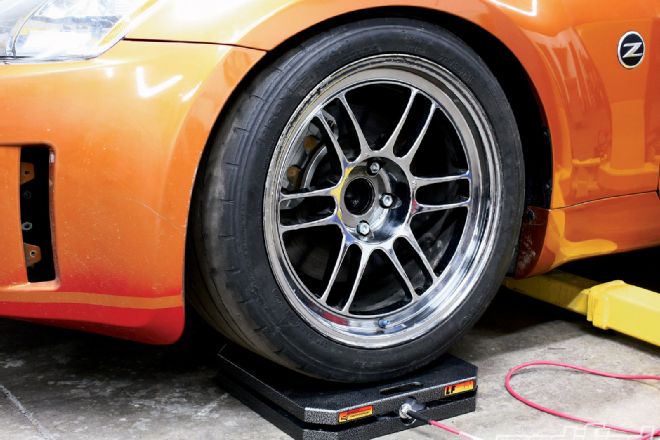Wheel Alignment
Corner balancing. If you've been around racing a little bit, you've surely heard this term before. Or perhaps you've heard NASCAR announcers talk about "wedge," which is basically the same thing. Corner balancing is commonly misunderstood, like many other things in the racing world, and we're here to help clear up exacltly what it is, what it's capable of and why you might want to balance your car. If you've ever installed a set of coilovers before, you know you can adjust the car's height, but have you ever wondered if there's more to it than just setting the fender gaps to be all the same? Of course there is! The most common analogy used with corner balancing is a chair, or stool, that teeter-totters. When it doesn't have all of its legs planted firmly in the ground, it's not corner balanced. In fact, it most likely carries 100 percent of your weight on just two of its legs. Needless to say, that's bad.
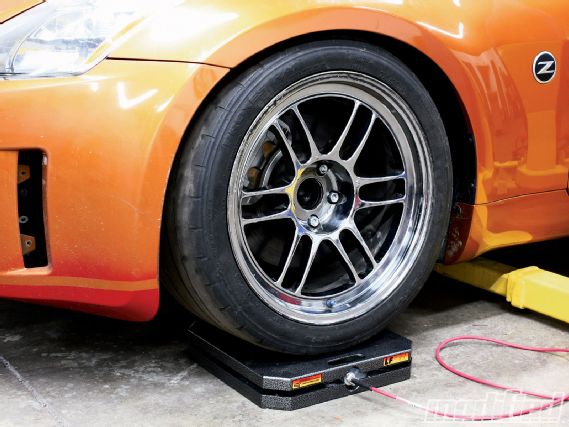 |
Wheel Alignment Specifications - Corner Balancing
|
Wheel Alignment Specifications - Corner Balancing
Our goal is to split the weight carried evenly between the two diagonal sets of wheels to improve predictable handling. Imagine raising the ride height of the left/front and right/rear wheels a ridiculous amount-say 10 inches. Imagine what the car would be like-it would be that teeter-tottering chair. You would literally be able to lift up and push down on the front/right fender and watch the car teeter back and fourth. Because we're working with a car resting on springs, the issue can still exist, even if it looks like the car is evenly planted on all fours to the untrained eye.
The next logical question is, So what? What if my corner balancing is off a little bit? I don't even fully understand what that means! Well, corner balancing is so important that most professional race teams in the world have a set of scales that they lug to every race. Actually, this may be the definition of a professional race team. You're not pro until you have scales and a bunch of wood to level the scales, because racetracks never seem to pave a flat paddock. Why would race teams do this if it didn't matter? Just to be balling? Perhaps. But most likely it's because when the corner balance is off, the car will have entirely different handling characteristics when turning in one direction versus the other. For example, if a car is heavy in the left/front and right/rear, yet light on the opposite corners, it will oversteer (or want to spinout) when turning left, yet understeer like a pig when turning right. It doesn't take much to really feel it. Even 1 or 2 percent will be noticeable to an experienced driver, and a bit more for the novice. Either way, it's no good, so let's talk about how to measure the issue and how to fix it.
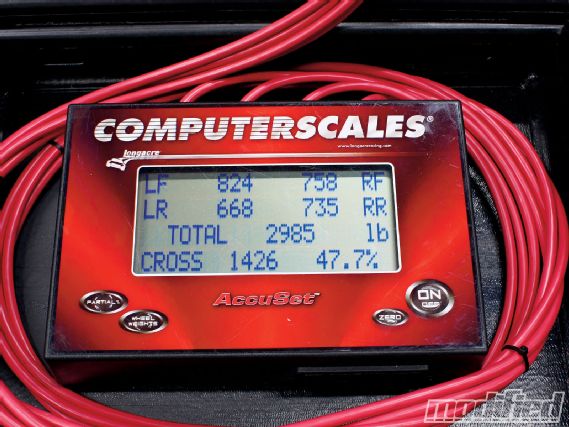 |
Wheel Alignment Specifications - Corner Balancing
|
Wheel Alignment Specifications - Corner Balancing
To measure the current weight and balance of the car requires scales. It's absolutely critical that the scales are perfectly level. Corner balancing your car on an uneven surface is possibly worse than not corner balancing it at all. It's also critical that the tire pressure is correct (set it to what your hot tire pressure would be out on track) because the lower the pressure, the lower that corner will sit.
Once our scales are set up and level, turned on and zero'd, we set our car on them. You'll notice from the photos we don't have roll-off ramps. A typical corner balancing setup will include some sort of runway to roll the car forward and back to eliminate all the tire bind from coming down off a hoist or jack. Rolling the car back and fourth many times is required without long roll-off ramps to ensure there's no preload in the system. The front wheels must also be straight because the caster of the front wheels alters the corner balance as the wheels turn. Lastly, you also need to make sure the sway bars don't have preload in them-that can also skew the results. If your sway bar endlinks are adjustable, it's an easy fix. If not, as long as the car is at the same ride height left to right, you should be OK. You can always check by removing a sway bar endlink at ride height and making sure it's easy to remove and insert.
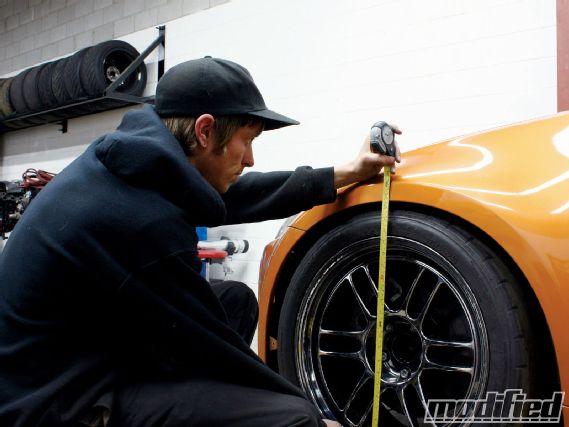 |
Measuring to the fender is an excellent and reliable method of checking ride height.
|
Measuring to the fender is an excellent and reliable method of checking ride height.
So here we are. A fresh set of coilovers, slapped on with no real attention to ride height (we actually made a few turns of coilover adjustment in random places to emphasize how off the corner balance can be), and we ended up with 47.7 percent of the car's total weight resting on the front/right, and rear/left wheels.
INITIAL CORNER BALANCE READING (NO DRIVER) LF 824 lbs Corner Balance 47.7% RF 758 lbs LR 668 lbs Total Weight 2,985 lbs RR 735 lbsThis means if we went out and ripped on the roadster in its current state, it would surely feel like it was "loose to the left, tight to the right." The reasons why are a little bit beyond the scope of this article, but feel free to contact me if you're curious and I'd be happy to explain (sanis@sg-motorsport.com).
If you're really catching on here, you'll realize that to make a corner heavier you simply have to raise the ride height at that corner; it's exactly the same as lengthening the short leg of the teeter-tottering chair. This requires ride height adjustment (usually coilovers) and can be done by adding spring preload; if you're using coilovers that are adjustable through shock length, it can be done by lengthening the overall shock body. The weight isn't coming from thin air, however. When we add weight to a diagonal pair of tires, it's because that same amount of weight has come off of the other two tires. In other words, raising a left/front will take that weight from the right/front and left/rear. The right/rear will also take a little bit of this weight for itself. The best way to visualize it is to use a jack and see what happens when you lift a corner of your car. The opposite diagonal wheel sinks into the ground because of all the weight that's on it and the two closest wheels droop because they have much less weight on them.
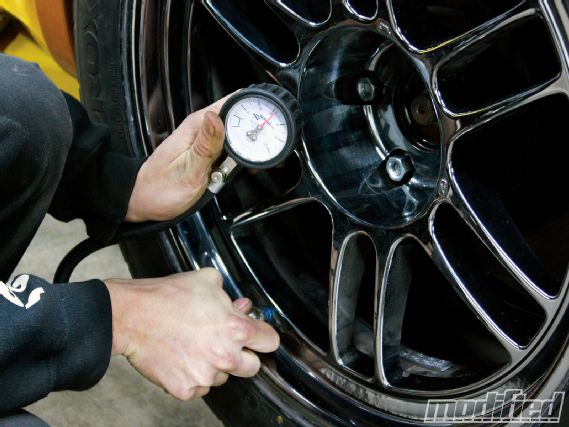 |
Ensuring tire pressure is accurate and to spec is critical for proper corner balancing.
|
Ensuring tire pressure is accurate and to spec is critical for proper corner balancing.
Before we get all crazy and start raising and lowering as we please, there must be some method to the madness. This is where measuring the ride height comes into play. The goal is to have the diagonal corner balance be 50 percent without skewing the ride height for aesthetic and aerodynamic reasons. Finally, make an observation by looking at the measured corner weights and notice how the front weights differ from each other by approximately 70 lbs and the rear also differs by approximately 70 lbs-both at opposing corners. That's what the 47.7 percent represents. This is what corner balancing is all about. We can fix this!
Remember, we can't physically move weight around without relocating components in the vehicle, so the total front weight will always be the same as the total rear weight. What we can do, however, is transfer the load from one set of diagonals to another. Keep this in mind and try to predict what will happen when we make our first adjustment.
Back to the ride height measurement-I typically measure from the bottom of the rim to the fender. This gives me a fairly accurate reading, assuming the car's body is fresh. If it's smashed up or abused, then you'll want to measure to the framerails, or in the case of a car with lots of aerodynamic goodies, measure splitter and diffuser height-that's really what's critical for those cars.
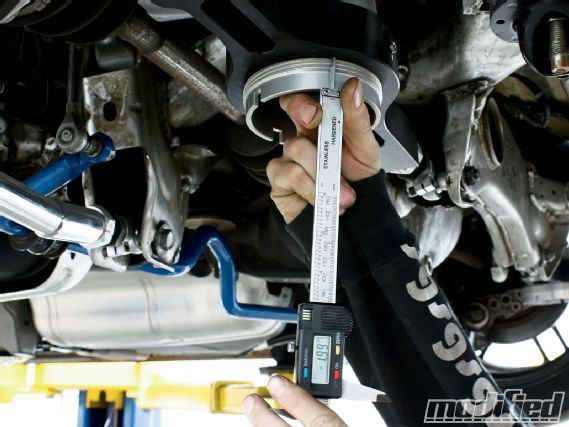 |
Measuring rear ride height adjustment.
|
Measuring rear ride height adjustment.
This is what we see from the roadster ride height:
INITIAL RIDE HEIGHT MEASUREMENT (NO DRIVER) LF 572mm Front Skew 2mm left RF 570mm LR 577mm Rear Skew 2mm right RR 579mmFrom looking at the ride height information, we need to decide what our goals are. In this case, my target ride height for the front axle (with driver) is 572mm and 580mm for the rear. Let's not be too picky on getting the ride height within a few mm of our absolute target, as long as side to side is exact and the corner balance is exact. From there, you could even adjust both wheels on a similar axle evenly to fine-tune the ride height without affecting the corner balance.
We know we need to get the right/front up 2mm and the left/rear up 2mm or so. Luckily for us, doing those two things is exactly the direction we need to go in to get the corner balance closer to 50 percent. Raising the left/rear will add weight to that diagonal, as will raising the front/right. Since this is the diagonal pair that are light (47.7 percent for the RF/LR), we're looking good.
Measuring rear ride height adjustment. At this point, we put the car up on the lift and raised both coilovers 2mm (we did so with spring preload in the rear of the 350Z and through shock length or droop adjustment in the front). Normally, 2mm at the spring would end up being more than that at the wheel (because of the motion ratio of the suspension), but since the wheels are now going to have more weight on them, typically we end up pretty close.
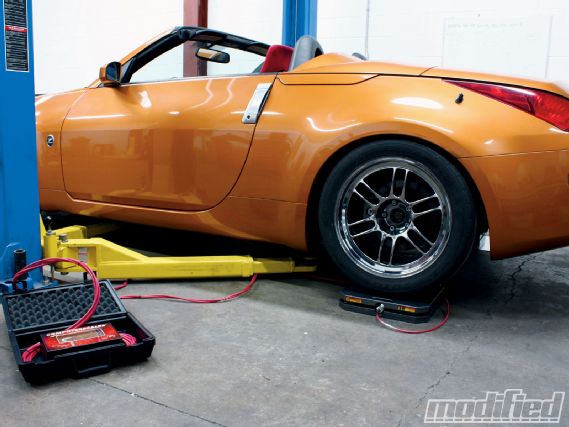 |
Wheel Alignment Specifications - Corner Balancing
|
Wheel Alignment Specifications - Corner Balancing
This is what we found for ride height and weight after making the first round of adjustments:
FIRST ADJUSTMENT CORNER BALANCE READING (NO DRIVER) LF 807 lbs Corner Balance 48.9% RF 776 lbs LR 685 lbs Total Weight 2,986 lbs RR 718 lbs FIRST ADJUSTMENT RIDE HEIGHT MEASUREMENT (NO DRIVER) LF 571mm Front Skew 1mm left RF 570mm LR 578mm Rear Skew 1mm right RR 579mmNow let's make a few quick observations. The corner balance improved by more than 1 percent, but the ride height doesn't seem to have changed at all. This is a perfect example of how sensitive a stiffly sprung car can be to corner balancing changes. While the car looks and measures almost exactly the same (1mm difference on the left), the cross weight is a full percent different. The reason the ride height didn't change as much as anticipated is because the corners we've raised (the rear/left and front/right) now have more weight on them. You'll also note that the total weight remains the same. You'll want to check this every time to ensure that you're getting an accurate reading and all the scale pads are placed square under the tires. It doesn't take much to cause confusion when corner balancing a car if the measurements aren't consistent.
The next adjustment we should make to achieve our target is actually the same thing we did the first time. We need more weight, and more ride height, on both the right/front and left/rear. It's not usually this simple, but because the chassis is so new, the ride heights are matching the weights very closely. I've scaled cars before that were so banana'd from abuse that the fender gaps and bumper to ground clearance had to be much higher on one corner than the other, and there was simply no way around it other than to even the gap out between the front and rear; don't be discouraged if you can't get your ride height perfect-achieving a 50 percent diagonal is your main priority.
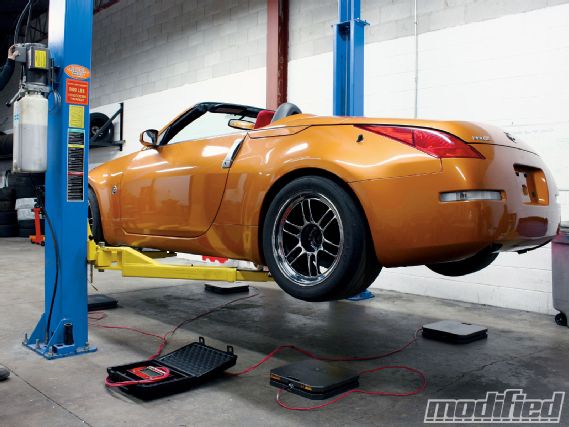 |
Using a hoist speeds the corner balancing process up significantly.
|
Using a hoist speeds the corner balancing process up significantly.
Before we make our third adjustment, it's time to put the driver in the car and see how the corner balance and ride height change. I typically expect to have the static ride height of the left side of the vehicle 1-3mm higher, depending on spring rate, to compensate for the driver's weight. To our amazement, the corner balance didn't change at all with the driver. This is because with the 350Z the driver is sitting almost directly in the middle of the front and rear wheels, thereby evenly weighing down the left side of the car and not adding any unbalanced weight. In many cars, the driver sits forward (or sometimes rearward) of center, which causes more weight on the left/front than the left/rear and that's where the imbalance comes from. This was the weight and ride height with the driver:
FIRST ADJUSTMENT CORNER BALANCE READING (W/ DRIVER) LF 854 lbs Corner Balance 48.9% RF 788 lbs LR 734 lbs Total Weight 3,112 lbs RR 736lbs FIRST ADJUSTMENT RIDE HEIGHT MEASUREMENT (W/DRIVER) LF 570mm Front Skew 0mm RF 570mm LR 578mm Rear Skew 1mm right RR 579mmThis also suggests that passenger or no passenger, the Z should keep its (relative) balance the same when cornering left or right. We then made our second adjustment to see how close we could come to a 50 percent corner balance. It got us close, but one further tiny lift to the right front was required to make it perfect:
FINAL ADJUSTMENT CORNER BALANCE READING (NO DRIVER) LF 791 lbs Corner Balance 50.0% RF 791 lbs LR 702 lbs Total Weight 2,986 lbs RR 702 lbs FINAL ADJUSTMENT RIDE HEIGHT MEASUREMENT (NO DRIVER) LF 572mm Front Skew 1mm left RF 571mm LR 581mm Rear Skew 0mm RR 581mmWe were amazed to see that the left-to-right balance of the 350Z was exactly 50 percent. This also means that with a corner balance of 50 percent, we're able to end up with axles that match each other exactly. But note that when we throw the driver in, the corner balance remains at 50 percent. The car is still perfectly balanced on its two diagonals, it's just a bit heavier on the left side now:
FINAL ADJUSTMENT CORNER BALANCE READING (W/DRIVER) LF 837 lbs Corner Balance 50.0% RF 803 lbs LR 750 lbs Total Weight 2,986 lbs RR 720lbs FINAL ADJUSTMENT RIDE HEIGHT MEASUREMENT (W/DRIVER) LF 571mm Front Skew 1mm left RF 571mm LR 580mm Rear Skew 0mm RR 581mmAnd there you have it. The roadster is now ready to rip in full fury, perfectly set up from alignment to corner balancing. Or is it? Nothing is quite that easy. Remember that everything affects everything else when it comes to suspension tuning. In the roadster's case, it should be OK, but large ride height adjustments will change the alignment of a car, just in the same way that large alignment changes could change the car's corner balancing. This is because changing camber, toe and caster can actually change the ride height. For this reason it's best to set the ride height where you want it, align the car and then corner balance it last. Usually, you'll be close enough that a few mm won't affect the alignment enough to measure.
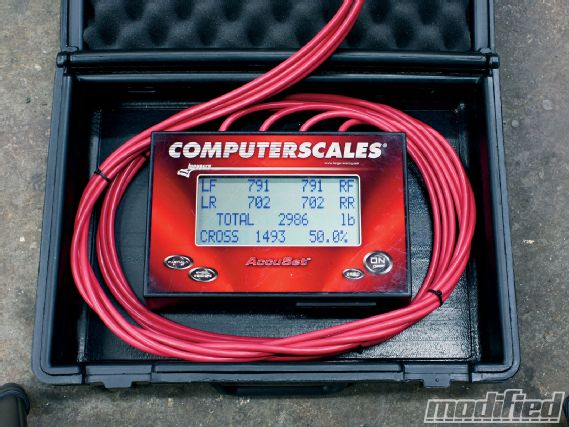 |
The final results of our corner balance. Perfect 50/50 weight distribution!
|
The final results of our corner balance. Perfect 50/50 weight distribution!
Now let me conclude with a few more observations to help make your corner balancing adventure a bit easier. First, you'll note that even though we never touched the front/left and rear/right, their ride heights went up. That's because they got significantly lighter over this process, as we took some of their weight and shifted it to the other diagonal pair.
Another thing to note is you can now realize how an uneven floor would seriously change the outcome of the real-world results. An uneven floor of only 1mm could be that 1 percent change we saw after the first change so get your platform level.
The last thing I want to mention, before anyone gets the impression that corner balancing is the be-all, end-all to suspension tuning, is that static weight distribution is and always will be most important. Corner balancing is simply optimizing what you have. If you scale your car and see that it's incredibly front/left heavy, and you know your battery is mounted in the front left of the car, consider moving it. Every time you move weight you help yourself twice over-with the weight you remove from the heavy area and again by adding the weight to the light area.
Good luck out there, everyone. Hopefully, one day you'll be running that pro team lugging around the scales, ramps and wood.

